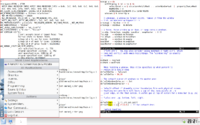Difference between revisions of "Xmonad/Using xmonad in KDE"
(Hmm, screen saver works now, don't know what I did) |
(Added prerequisite that xmonad is installed) |
||
| Line 34: | Line 34: | ||
== Before you begin == |
== Before you begin == |
||
| + | |||
| + | Make sure that xmonad is installed. |
||
| + | On most systems, you can just install the xmonad package |
||
| + | using [http://www.general.uwa.edu.au/u/toivo/kpackage/ KPackage] |
||
| + | or your favorite package manager. |
||
| + | For a list of systems with pre-built xmonad binaries, see |
||
| + | the '''"ports and distributions"''' section |
||
| + | on the [http://xmonad.org/ main xmonad page]. |
||
| + | Or you can [http://xmonad.org/intro.html build xmonad from source]. |
||
Make sure that KDE is not configured for multiple desktops. |
Make sure that KDE is not configured for multiple desktops. |
||
Revision as of 11:18, 27 April 2008
Here's how to configure Xmonad to work with KDE.
Motivation
You've heard about the wonders of Xmonad, and you want to try it out. But you're a KDE user, and you want to stay with KDE because of:
- Ability to browse all programs and utitlities with desktop bar (kicker).
- Easy integration of Xmonad on a system using kdm for logins.
- Easier system monitoring on laptops with networking widget.
- Best environment for running GUI applications developed with Qt.
- Consistent user interface and shared system services for the vast collection of KDE applications.
- You're just used to it.
Then this page is for you.
Related reading
The GNOME/xmonad page. Read that, really. Much of what is written there also applies to KDE and is not repeated here.
But if all you want is to get started quickly with Xmonad in KDE, read on.
Versions
The following instructions are optimized and tested (so far) for xmonad 0.7 and KDE 3.5.
Before you begin
Make sure that xmonad is installed. On most systems, you can just install the xmonad package using KPackage or your favorite package manager. For a list of systems with pre-built xmonad binaries, see the "ports and distributions" section on the main xmonad page. Or you can build xmonad from source.
Make sure that KDE is not configured for multiple desktops. To configure that, open the KDE Control Center, select Desktop > Multiple desktops, and set the number of desktops to 1.
Sample xmonad configuration for KDE
As usual, place xmonad configuration in ~/.xmonad/xmonad.hs.
The following sample configuration sets up xmonad to cooperate with the KDE desktop and panel; for more details about how this works, see the Gnome page.
This configuration also does the following:
- uses the Windows key instead of the Alt key as "mod" for xmonad (freeing up Alt for common emacs-style key bindings in applications)
- causes certain applications to launch as floating windows
- automatically sends certain applications to a specific desktop when they launch.
import XMonad
import XMonad.Hooks.ManageDocks
import XMonad.Hooks.EwmhDesktops
import qualified XMonad.StackSet as W
main = xmonad $ defaultConfig
{ manageHook = manageHook defaultConfig <+> myManageHook
, logHook = ewmhDesktopsLogHook
, layoutHook = avoidStruts $ layoutHook defaultConfig
, modMask = mod4Mask -- use the Windows button as mod
}
where
myManageHook = composeAll . concat $
[ [manageDocks]
, [ className =? c --> doFloat | c <- myFloats]
, [ title =? t --> doFloat | t <- myOtherFloats]
, [ className =? c --> doF (W.shift "2") | c <- webApps]
, [ className =? c --> doF (W.shift "3") | c <- ircApps]
]
myFloats = ["MPlayer", "Gimp"]
myOtherFloats = ["alsamixer"]
webApps = ["Firefox-bin", "Opera"] -- open on desktop 2
ircApps = ["Ksirc"] -- open on desktop 3
Note: To get the class name of an application for use in the above:
- Open the application.
- Enter the command
xprop | grep WM_CLASSin a terminal window on the same desktop. - Click on the application window.
- Read the class name in the terminal window. The class name is the second of the two quoted strings displayed, usually capitalized.
Thanks to everyone on #xmonad, especially sjanssen, for all the help in putting together this sample xmonad configuration for KDE.
Make xmonad your window manager in KDE
Create the directory ~/.kde/env if it does not
already exist. Create a file there called set_window_manager.sh
containing only the following line of text:
KDEWM=/path/to/xmonad
where "/path/to/xmonad" is the path to the xmonad
binary on your system. For example, on Debian systems this
is /usr/bin/xmonad. If you compiled xmonad
from source, it may be something like /home/$USER/bin/xmonad.
Restart your KDE session
Now end your current KDE session and start a new one. Welcome to xmonad with KDE!
Tips and issues
- As in Gnome, you currently cannot switch the focus to a window by clicking on it in the task bar. Use xmonad keys, or use the mouse on the window itself.
- Also as in Gnome, it is very important not to use the xmonad
mod-shift-qkey to exit your session. Use the KDE menu or panel applet. How do you bind an xmonad key to exit a KDE session?
